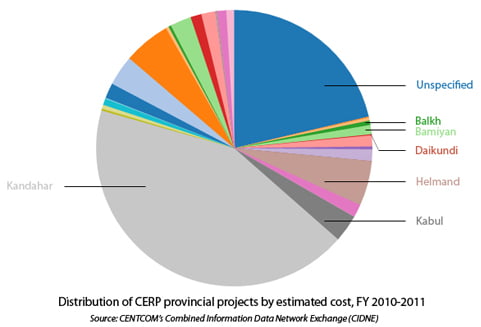A report published last week by the Democratic staff of the Senate Foreign Relations Committee paints a grim picture of American aid in Afghanistan. It unabashedly critiques the aid channeled through the USAID and the State Department and attacks the much-revered doctrine of counterinsurgency.
The US Army iteration of counterinsurgency, or COIN, is a brainchild of Gen. Petraeus who successfully used a combination of military force and aid to more or less quell much of the worst violence in Iraq. This led to a belief that if it worked in Iraq, it must also work in Afghanistan. Not so. Says the report:
We are pursuing an assistance strategy based on counterinsurgency theories that deserve careful, ongoing scrutiny to see if they yield intended results.
In fact, the violence perpetrated by the Taliban has not only caused serious deterioration of security but also dangerously skewed the focus of US aid projects in Afghanistan. The report highlights that about 80% of USAID’s resources are being spent on Afghanistan’s south and east – its most violent areas – on stabilization projects that have yielded “limited” results. To illustrate this point further, let’s take a look at the table below from USAID figures for FY 2009 and 2010 and UNHCR population estimates for 2008-2009.
| Province | Population | Allocation ($) | Allocation per capita ($) |
| Balkh | 1,144,800 | 64,575,376 | 56.41 |
| Daikundi | 410,300 | 24,805,551 | 60.46 |
| Bamiyan | 398,000 | 32,697,795 | 82.15 |
| Kandahar | 1,057,500 | 143,864,174 | 136.04 |
| Helmand | 821,800 | 183,562,873 | 223.37 |
The stable provinces of Balkh, Daikundi and Bamiyan received considerably less aid per capita than Kandahar and Helmand, arguably the worst insurgency-hit provinces in the country. The report doesn’t cover the Commander’s Emergency Response Program (CERP) – which gives money to soldiers on the field for projects in their areas – but the same trend of investment in volatile provinces can also be seen there:
Yet, as US foreign assistance increased from 1.1 billion in 2006 to 4.1 billion in 2010, and CERP spending increased from 215 million to one billion in the same time-frame, UNAMA statistics show that annual civilian casualties increased from 929 to 2,777. Most of these casualties were from insurgent violence in the volatile areas.
The lesson is that throwing billions of dollars at unstable provinces does not automatically generate peace or prosperity in those areas. Violence has caused many of the most qualified people to find opportunities elsewhere. It is unsurprising, then, that despite receiving so much attention, the human development index indicators are no better in these regions than elsewhere in Afghanistan. Despite this, the aid allocation approach has reinforced the perception in the more peaceful areas of the country that peace doesn’t pay, violence does.
COIN, implemented in an environment of urgency to produce quick results, is fundamentally inconsistent with the Government of Afghanistan’s priorities. COIN’s focus on short-term goals stunts sustainable growth, especially because so much of the aid money is channeled not through, but parallel to, the Afghan government. The Afghan National Development Strategy has stood largely neglected by donors who are not only concerned about the ability of the Government of Afghanistan to implement projects but also want to spend on their own areas of priority.
For example, the “goodwill” or “cooperation” generated from “graveling of 1500 meters of road” or “installation of electricity in local mosque” – actual CERP projects in Kandahar – can only lead to short-term actionable intelligence at best; it cannot make a sustainable difference. In fact, this short-term approach to aid is partly why most provinces still remain remote and most Afghan cities, including the capital, remain submerged in darkness at night.
The insurgency has not only killed thousands in unstable areas but also deprived the peaceful provinces of meaningful development. The approach to aid in Afghanistan must be reassessed if indeed genuine, long-term development is desired. The Senate report makes several useful recommendations, including the “careful, ongoing scrutiny” of aid allocation based on the COIN doctrine. I would add actually making adjustments where the data call for it.

